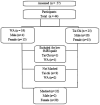Differences in brain connectivity between older adults practicing Tai Chi and Water Aerobics: a case-control study
- PMID: 39323912
- PMCID: PMC11422087
- DOI: 10.3389/fnint.2024.1420339
Differences in brain connectivity between older adults practicing Tai Chi and Water Aerobics: a case-control study
Abstract
Background: This study aimed to investigate the neural mechanisms that differentiate mind-body practices from aerobic physical activities and elucidate their effects on cognition and healthy aging. We examined functional brain connectivity in older adults (age > 60) without pre-existing uncontrolled chronic diseases, comparing Tai Chi with Water Aerobics practitioners.
Methods: We conducted a cross-sectional, case-control fMRI study involving two strictly matched groups (n = 32) based on gender, age, education, and years of practice. Seed-to-voxel analysis was performed using the Salience, and Frontoparietal Networks as seed regions in Stroop Word-Color and N-Back tasks and Resting State.
Results: During Resting State condition and using Salience network as a seed, Tai Chi group exhibited a stronger correlation between Anterior Cingulate Cortex and Insular Cortex areas (regions related to interoceptive awareness, cognitive control and motor organization of subjective aspects of experience). In N-Back task and using Salience network as seed, Tai Chi group showed increased correlation between Left Supramarginal Gyrus and various cerebellar regions (related to memory, attention, cognitive processing, sensorimotor control and cognitive flexibility). In Stroop task, using Salience network as seed, Tai Chi group showed enhanced correlation between Left Rostral Prefrontal Cortex and Right Occipital Pole, and Right Lateral Occipital Cortex (areas associated with sustained attention, prospective memory, mediate attention between external stimuli and internal intention). Additionally, in Stroop task, using Frontoparietal network as seed, Water Aerobics group exhibited a stronger correlation between Left Posterior Parietal Lobe (specialized in word meaning, representing motor actions, motor planning directed to objects, and general perception) and different cerebellar regions (linked to object mirroring).
Conclusion: Our study provides evidence of differences in functional connectivity between older adults who have received training in a mind-body practice (Tai Chi) or in an aerobic physical activity (Water Aerobics) when performing attentional and working memory tasks, as well as during resting state.
Keywords: Stroop; Tai Chi; embodied cognition; fMRI; functional connectivity; longevity; mind–body; self-regulation.
Copyright © 2024 Port, Paulo, de Azevedo Neto, Lacerda, Radvany, Santaella and Kozasa.
Conflict of interest statement
The authors declare that the research was conducted in the absence of any commercial or financial relationships that could be construed as a potential conflict of interest. The author(s) declared that they were an editorial board member of Frontiers, at the time of submission. This had no impact on the peer review process and the final decision.
Figures




Similar articles
-
Cognition and brain function in elderly Tai Chi practitioners: A case-control study.Explore (NY). 2018 Sep;14(5):352-356. doi: 10.1016/j.explore.2018.04.007. Epub 2018 Jul 20. Explore (NY). 2018. PMID: 30122327
-
Different modulation effects of Tai Chi Chuan and Baduanjin on resting-state functional connectivity of the default mode network in older adults.Soc Cogn Affect Neurosci. 2019 Feb 13;14(2):217-224. doi: 10.1093/scan/nsz001. Soc Cogn Affect Neurosci. 2019. PMID: 30690554 Free PMC article.
-
Resting state functional connectivity as a predictor of brief intervention response in adults with alcohol use disorder: A preliminary study.Alcohol Clin Exp Res (Hoboken). 2023 Aug;47(8):1590-1602. doi: 10.1111/acer.15123. Epub 2023 Aug 12. Alcohol Clin Exp Res (Hoboken). 2023. PMID: 37572293
-
Tai Chi Chuan and Baduanjin practice modulates functional connectivity of the cognitive control network in older adults.Sci Rep. 2017 Feb 7;7:41581. doi: 10.1038/srep41581. Sci Rep. 2017. PMID: 28169310 Free PMC article.
-
Resting-state fMRI functional connectivity and mindfulness in clinical and non-clinical contexts: A review and synthesis.Neurosci Biobehav Rev. 2022 Apr;135:104583. doi: 10.1016/j.neubiorev.2022.104583. Epub 2022 Feb 22. Neurosci Biobehav Rev. 2022. PMID: 35202647 Free PMC article. Review.
Cited by
-
Multi-domain Online Therapeutic Investigation Of Neurocognition (MOTION) - A randomized comparative-effectiveness study of two remotely delivered mind-body interventions for older adults with cognitive decline.Contemp Clin Trials. 2025 Feb;149:107811. doi: 10.1016/j.cct.2025.107811. Epub 2025 Jan 12. Contemp Clin Trials. 2025. PMID: 39809343 Free PMC article. Clinical Trial.
References
-
- Beck A. T., Epstein N., Brown G., Steer R. A. (1988a). An inventory for measuring clinical anxiety: psychometric properties. J. Consult. Clin. Psychol. 56, 893–897. - PubMed
-
- Beck A. T., Steer R. A., Carbin M. G. (1988b). Psychometric properties of the Beck depression inventory: twenty-five years of evaluation. Clin. Psychol. Rev. 8, 77–100.
LinkOut - more resources
Full Text Sources

